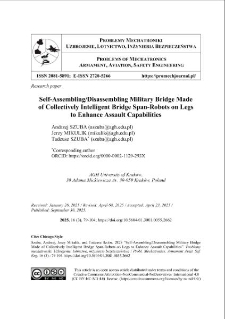Our Digital Library contains 1 868 digital objects
Object
Title: Self-Assembling/Disassembling Military Bridge Made of Collectively Intelligent Bridge Span-Robots on Legs to Enhance Assault Capabilities
Alternative title:
Contributor:
Abstract:
Several specialised implementations of military bridge systems may be distinguished. However, none of them is capable of simultaneously offering all of the following characteristics: versatility, scalability, immediate assembly, ground/terrain survey, low number of staff and low workload. The aim of the article is to present the progress of designing a rather new robotic military bridge system complying with MLC70 and MLC110 standards. It is composed of 11.5 m long mobile AI robots that resemble bridge spans. It is assumed that bridge span-robots are capable of walking short distances to the assembly location, using their strong telescopic legs. In the case of longer distances, the system needs to be transported on specialised semi-trailers. The robots are assumed to be able to disembark/embark such semi-trailers and are also expected to be able to configure themselves and couple with each other to create a bridge ribbon, using railway-like couplers for this purpose. The system is expected to be autonomous, as it is designed to rely on Collective Intelligence. Therefore, only truck drivers and 2-3 qualified technicians would be required to transport and supervise the operation of the robots. The article describes how the key elements of the solution have been combined into a single, compatible and economically feasible system. In order to provide a better understanding of the solution, additional articles are planned in the future. In accordance with military tactics, trucks and trailers transporting bridge span-robots will be attached to fast-moving armoured brigades, as long as local roads may be used. Then, the Intelligent Bridge will self-assemble and will enable to quickly pass through difficult local terrain with such obstacles as rivers, ravines, marshlands, and even engineering barriers consisting of anti-tank ditches and the so-called dragon's teeth. The assumption is that the robotized bridge will enable trucks and semi-trailers to pass a given obstacle. In the next phase, the bridge-robots will pass the obstruction as well, only to self-load onto the semi-trailers and to follow the armoured brigade they are embedded with. The use of telescopic legs as well as the individual and collective intelligence of robots are of crucial significance from the technological point of view. The article presents the outcomes of more than 10 years of research and VR modelling efforts.
Place of publishing:
Warszawa
Publisher:
Date created:
Date submitted:
Date accepted:
Date issued:
Extent:
Identifier:
oai:ribes-88.man.poznan.pl:2743
Call number:
Electronic ISSN:
Print ISSN:
Language:
License:
Rights holder:
Starting page:
Ending page:
Volume:
Journal:
Keywords:
Object collections:
Last modified:
Oct 17, 2025
In our library since:
Oct 17, 2025
Number of object content hits:
0
All available object's versions:
https://ribes-88.man.poznan.pl/publication/3084

